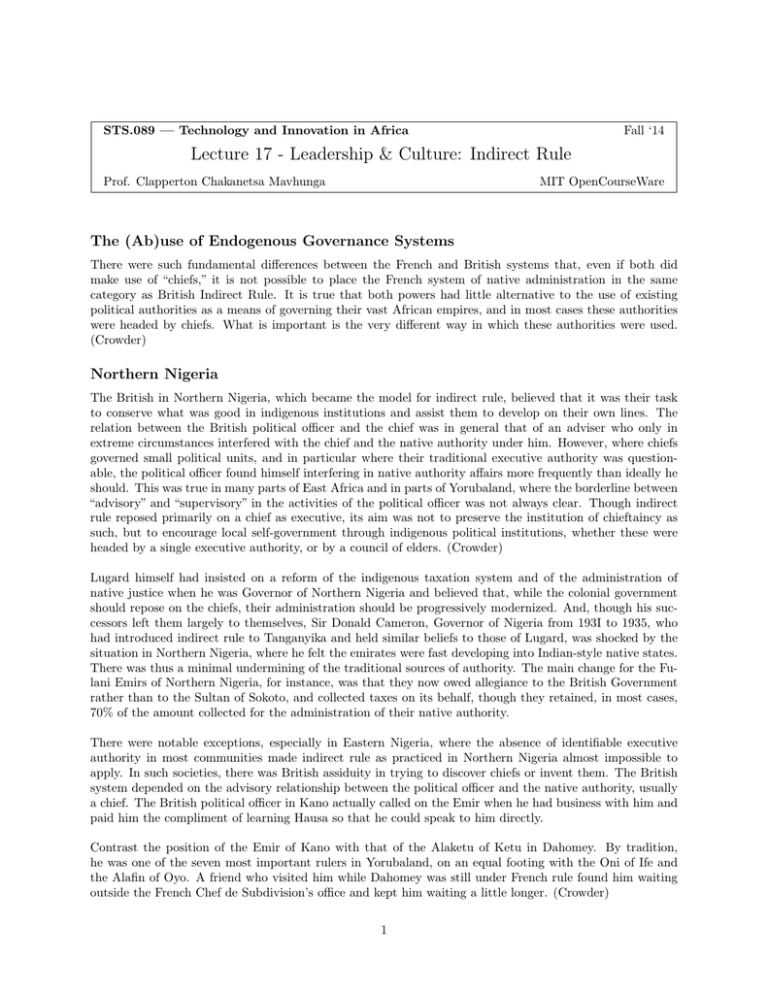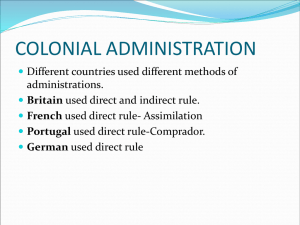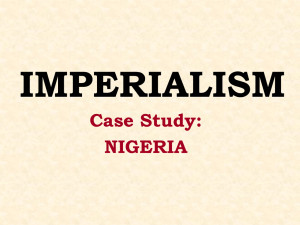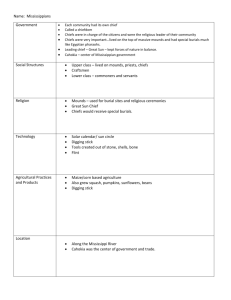Lecture 17 - Leadership & Culture: Indirect Rule
advertisement

STS.089 — Technology and Innovation in Africa Fall ‘14 Lecture 17 - Leadership & Culture: Indirect Rule Prof. Clapperton Chakanetsa Mavhunga MIT OpenCourseWare The (Ab)use of Endogenous Governance Systems There were such fundamental differences between the French and British systems that, even if both did make use of “chiefs,” it is not possible to place the French system of native administration in the same category as British Indirect Rule. It is true that both powers had little alternative to the use of existing political authorities as a means of governing their vast African empires, and in most cases these authorities were headed by chiefs. What is important is the very different way in which these authorities were used. (Crowder) Northern Nigeria The British in Northern Nigeria, which became the model for indirect rule, believed that it was their task to conserve what was good in indigenous institutions and assist them to develop on their own lines. The relation between the British political officer and the chief was in general that of an adviser who only in extreme circumstances interfered with the chief and the native authority under him. However, where chiefs governed small political units, and in particular where their traditional executive authority was question­ able, the political officer found himself interfering in native authority affairs more frequently than ideally he should. This was true in many parts of East Africa and in parts of Yorubaland, where the borderline between “advisory” and “supervisory” in the activities of the political officer was not always clear. Though indirect rule reposed primarily on a chief as executive, its aim was not to preserve the institution of chieftaincy as such, but to encourage local self-government through indigenous political institutions, whether these were headed by a single executive authority, or by a council of elders. (Crowder) Lugard himself had insisted on a reform of the indigenous taxation system and of the administration of native justice when he was Governor of Northern Nigeria and believed that, while the colonial government should repose on the chiefs, their administration should be progressively modernized. And, though his suc­ cessors left them largely to themselves, Sir Donald Cameron, Governor of Nigeria from 193I to 1935, who had introduced indirect rule to Tanganyika and held similar beliefs to those of Lugard, was shocked by the situation in Northern Nigeria, where he felt the emirates were fast developing into Indian-style native states. There was thus a minimal undermining of the traditional sources of authority. The main change for the Fu­ lani Emirs of Northern Nigeria, for instance, was that they now owed allegiance to the British Government rather than to the Sultan of Sokoto, and collected taxes on its behalf, though they retained, in most cases, 70% of the amount collected for the administration of their native authority. There were notable exceptions, especially in Eastern Nigeria, where the absence of identifiable executive authority in most communities made indirect rule as practiced in Northern Nigeria almost impossible to apply. In such societies, there was British assiduity in trying to discover chiefs or invent them. The British system depended on the advisory relationship between the political officer and the native authority, usually a chief. The British political officer in Kano actually called on the Emir when he had business with him and paid him the compliment of learning Hausa so that he could speak to him directly. Contrast the position of the Emir of Kano with that of the Alaketu of Ketu in Dahomey. By tradition, he was one of the seven most important rulers in Yorubaland, on an equal footing with the Oni of Ife and the Alafin of Oyo. A friend who visited him while Dahomey was still under French rule found him waiting outside the French Chef de Subdivision’s office and kept him waiting a little longer. (Crowder) 1 Lecture 17 Leadership & Culture: Indirect Rule STS.089, Fall ’14 Criteria for Chefs de Canton It is clear then that the French explicitly changed the very nature of the powers of the chief and that “his functions were reduced to that of a mouthpiece for orders emanating from outside.” The Chefs de Canton (&c.) are recruited: i. for preference from among the descendants of old families traditionally or customarily destined to command ii. from among notable natives, literate if possible, who have rendered services to the French cause and who are fitted to fill these functions by their authority or influence in the country iii. from among the Chefs de Canton (&c) who have satisfactorily carried out their functions for at least four years iv. from among old soldiers who have completed more than the normal terms of service and who qualify for special treatment v. from among local civil servants (clerks, interpreters, &c.) who have worked satisfactorily for at least four years in the public service The following are the disciplinary measures applicable to Chefs de Canton (&c.) i. reprimand by the Chef de Department ii. temporary withholding of salary iii. temporary interdiction iv. reduction of salary v. dismissal Since the chiefs did not, except in rare cases, represent traditional authority and since they were the agents of the colonial power for carrying out its more unpopular measures, such as collecting taxes and recruiting for labor, they were resented in most parts of French West Africa. While they retained no traditional judicial authority such as that of their counterparts in British West Africa in their Native courts, they were agents of the law and in this case the unpopular system of summary administrative justice known as the indigenat. (Crowder) In Light of Complaints about the Corruption of Traditional Leaders... Hence it was not surprising that when, in 1957, just before the independence of Guinea, Sekou Toure (then Vice-President du Conseil) decided to do away with chiefs. The operation was effected with remarkably little protest from either the indigenous population or from the French administration that had made use of them. The chiefs no longer possessed political traditional authority and had become mere agents of the administration. This is a far cry from Nigeria of the day, where in the North the opposition party (N.E.P.U.) were trying unsuccessfully to rouse the people against the chiefs and where the Government of Eastern Nigeria. In African countries where the British had imposed chiefs, as in Eastern Nigeria and parts of Uganda, their prestige had in fact gone up, but this has certainly not been true in the former French territories. (Crowder) 2 Lecture 17 Leadership & Culture: Indirect Rule STS.089, Fall ’14 Paternalism/Separate Development vs Assimilation/évolué Why this great difference in approach by the two powers to the question of native administration, given that both for reasons of economy had to administer their vast African possessions with the aid of “chiefs”? The difference has much to do with difference in national character and political traditions. While few would disagree that the British were inspired by the concept of separate development for their African territories, there is still much debate as to how far the French were inspired by the concept of assimilation even after its formal abandonment as official policy in favour ofapolitique d’association. (Crowder) David Henige & the Complexity of (In)direct through Chiefly Political Systems in “Ghana” Here, then, the problem should not be considered so much as deviation from a “norm” since these stools, mostly established after the arrival of the Europeans on the coast, were influenced as much by earlier Guan practices and by intrusive European institutions as by those of the Akan. In 1939, the District Commissioner at Cape Coast thought that the Mkusukum electors “may seek a candi­ date from some other family should the present stool family [Twidan] not produce a satisfactory candidate in the near future” and he advised them not to change without government sanction. (Henige) Interference & Instrumentalization of African Endogenous Governance Systems In Dadiesoaba, an Asante stool, there was a change from “the rightful line” at some indeterminate time. In Ajumaku, the State Council decided in 1931 to “change the line of succession” since it was “dissatisfied with the manner in which the Stool Family [has] conducted the affairs of the State.” The Council advanced the argument that the unwanted stool family had only been “caretakers” after all and that the change was no more than a return to an earlier, more correct, state of affairs. Any change in ruling line, no matter how permanent it had become, could easily be interpreted as orig­ inally having been intended as a temporary expedient. Occasionally this argument, when advanced by the “original” ruling line, was successful. But if the “new” line had been ruling for a reasonably long period, the colonial administration usually rejected the plea for reversion unless other considerations supervened. Changes in ruling line have almost certainly occurred in other Akan paramount stools; regrettably, though, the data for these are less full and unambiguous. (Henige). Distortions & Caricatures Although because of broad eligibility, succession undoubtedly circulated widely in the precolonial period, the perception of a rotating system of succession was probably the result of the practice of the Gold Coast government after c. 1915 to require that a questionnaire be completed before an election could be confirmed and gazetted. Among the questions were those asking how many “houses” were eligible to fill the paramount stool and the “house” to which the applicant belonged. We know that one Kwamina Hammah had been enstooled in 1889 and that his ancestor Hammah had been destooled about twenty years before that, after which members of a different house (or abusua?) seem to have ruled. After 1889, however, only members of the “restored” line had been elected. (Henige) Direct Interference to Regularize Stools as Structures of ”Indirect” Rule In their dealings with African traditional authorities, the British sought to impose a hierarchical system at the apex of which a large number of rulers were recognized as amanhin or “Head Chiefs” and granted juris­ diction over a number of other stools. The implementation of this structure, principally between 1895 and 3 Lecture 17 Leadership & Culture: Indirect Rule STS.089, Fall ’14 1905, was adventitious and based as much on expediency and reflexive response as on any close appreciation of the dynamics of the traditional political structure. In both Agona and Gomoa, substools claimed and eventually received paramount status with the former paramount stool lapsing into subordinate status. In Agona (that is, Fante, and not Asante Agona) the Nyakrom stool was recognized as paramount over Agona state in 1931, replacing the Nsaba stool, which had been recognized as paramount by the British in 1905, and apparently by the Agona themselves long before that. The British, who also were familiar with the printed versions of this episode, accepted the Nyakrom ruler’s assertion that his ancestors once held the paramountcy but the decision to transfer recognition was based on what appeared to the colonial authorities to be widespread dissatisfaction with the Nsaba ruler. The experiment (as, from the British point of view, it was) was not a success. Of the five Nyakrom amanhin between 1935 and 1944, two were destooled, two others abdicated to avoid destoolment, and the fifth was killed in a motor accident. Not surprisingly the British regarded the situation as “a real nightmare” and reconstituted Nsaba as the paramount stool in 1945. But affairs in Agona had become too complex to be resolved so easily and eventually both Nsaha and Nyakrom were recognized as paramount stools by the National Liberation Council in 1968. (Henige) Traces & Their Uses Were the widely variegated succession patterns discussed here the result of colonial exigencies or do they represent merely the continuation, perhaps even in attenuated forms, of aspects of Akan political culture before the advent of colonial rule? The first problem concerns the nature of our sources for traditional stool politics during the colonial era. Little of our information about Akan succession practices –whether pre-colonial or colonial –is derived from unbiased data. The available records consist primarily of testimony given during stool, succession, and jurisdictional disputes and enquiries into public disorders. In putting forward this view it is important to remember that the testimony advanced in support of succes­ sion changes usually cited pre-colonial precedents. Some of the anomalies of succession practices in Offinsu have been attributed by Crook to the willingness of the Offinsu traditional authorities to play “the colonial game”; that is, to be percipient enough to recognize British predilections and to seek to conform to them by citing traditional precedents. (Henige) New Wine, Old Bottles Was this “colonial game” a new departure or did it represent a continuation of previous activities with only a change in the identity of the paramount? The introduction of new elements like the questionnaires stimulated what were likely to have been new responses, but were these not perhaps more in the nature of new wine in old bottles? (Henige) 4 MIT OpenCourseWare http://ocw.mit.edu STS.089 Technology and Innovation in Africa Fall 2014 For information about citing these materials or our Terms of Use, visit: http://ocw.mit.edu/terms.








